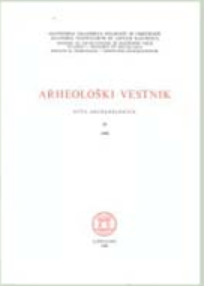The Prehistoric Malence
Abstract
Some 30 metres from the place where the river Krka flows into the river Sava we find on its right shore a triangularly shaped plateau situated at the entrance into the Krka river valley. In the forest behind this plateau there is a group of prehistoric tumuli which were excavated by Jernej Plečnik in years 1890 and 1891. From these tumuli originates the material which is now preserved at the National Museum in Ljubljana. During a recent study of this material everything has been found in the same condition in which it was brought into the museum. This has been a basic factor in our subsequent study of this material. Two grave units could be established on the basis of notes made by Rutar, and on the basis of a sketch of these graves. Both graves were excavated in the tumulus No. IY (see our plan), at a depht of two and a half metres. The first was a skeleton grave of a warrior (fig. 1) ; the bones, however, have not been preserved in it due to the type of soil this grave contains. A dish[1]shaped helmet (pl. II, fig. 5 & 5 a) was found in this grave together with a belt buckle made of bronze which is still connected with a piece of leather adorned with punched meanders (pi. III. 1). a fragment of a small bronze vessel (pi. Ill,6—6 c), fragments of a bronze situla (pi. Ill, 3), an iron point of a spear (pi. Ill, 7), an iron nail (pl. II, 1), bronze whorls (pl. II, 3, 4, 7—11), various bronze rings (rings depicted on pl. VII), and a clay dish with its handle reaching above its margin (pl. II, 6). On the basis of the dish-shaped helmet and of the buckle adorned with meanders we can place this grave unit into the initial phases of the Ha D period. In the same tumulus a female skeleton grave has also been excavated (see the sketch of the grave, fig. 2). This grave contained a large number of amber beads, decorations made of gold in the shape of a clover-leaf (pl. XII, 31), gold pearls which have not been preserved, and four very small boat-shaped fibulae (it can no longer be determined with certainty which are these fibulae). On the basis of clover-shaped decorations and in analogy to Stična we can place this grave into the Ha C period. During our investigations we have found in the same box which bears the date 1892 two fragments of a cylindrical urn (pl. I, 2), the bow of a peschieroid fibula (pl. I, 1), and a fragment of a torques (pl. I, 3) with its central part flat[1]tened. These articles are typical of the varieties of forms that can be found in the culture of urn field graves, and that in its initial phases. All the remaining articles can be discussed from the typological aspect only since nothing has been known about the circumstances in which they were found; neither can anything precise by established on the basis of notes made by Rutar (see plates IV—XIX). The Malence culture reached its highest development during the Ha C and HaD periods, and it is from these periods that the tumuli found in the forest behind the Malence plateau originate. This culture, however, did not cease to exist during' the younger periods of Irone Age, a fact which is supported by some articles that are younger than the two periods (pl. XVI, 9; pl. XIII, 20; pl. XIII, 15; pl. XIII, 2—6). We come to the conclusion that the Malence area was inhabited from the first beginnings of the culture of the um fields, through the older and younger Iron Ages, and down to the Roman period when the triangularly shaped plateau could be used as a refuge by people who escaped from the destroyed Nevio[1]dunum. It will be by means of a systematic survey only that the open problems will be solved, and in this way only we will be able to obtain a new under[1]standing of the material here collected.
Downloads
Downloads
Published
How to Cite
Issue
Section
License

This work is licensed under a Creative Commons Attribution-NonCommercial-ShareAlike 4.0 International License.
Authors guarantee that the work is their own original creation and does not infringe any statutory or common-law copyright or any proprietary right of any third party. In case of claims by third parties, authors commit their self to defend the interests of the publisher, and shall cover any potential costs.
More in: Submission chapter





